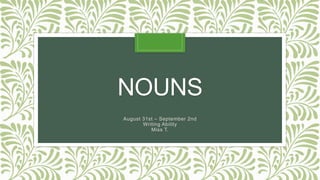
Nouns
- 1. NOUNS August 31st – September 2nd Writing Ability Miss T.
- 2. Why are nouns important? • A noun is a word that functions as the name of something. • Nouns are the most common class of word in English.
- 3. We will be looking at: 1. Common Nouns 2. Proper Nouns 3. Compound Nouns 4. Countable Nouns 5. Uncountable Nouns 6. Collective Nouns 7. Abstract Nouns 8. Concrete Nouns 9. Verbal Nouns
- 4. What is a COMMON NOUN? • Common nouns are used to name a GENERAL type of person, place or thing. • Common nouns can be divided into smaller classes such as countable and uncountable nouns, concrete and abstract nouns, collective nouns, and verbal nouns.
- 5. What is a PROPER NOUN? • Proper nouns are used to name a SPECIFIC person, place or thing. • In English, proper nouns begin with a capital letter. • Proper nouns do not normally have a determiner before them (e.g. the London, the Paul, etc.)
- 6. What is a COMPOUND NOUN? • Compound nouns are two or more words that create a noun. • Compound nouns are sometimes one word. • Compound nouns can be joined by a hyphen. • Compound nouns can be separate words. • In many compound nouns, the first word describes or modifies the second word, giving us insight into what kind of thing an item is, or providing us with clues about the item’s purpose. The second word usually identifies the item.
- 7. When do we use a hyphen? • The rules on whether to put a hyphen, a space, or nothing between the words in a compound noun are inconsistent. • Usually, a hyphen is used to eliminate ambiguity. • Ambiguity is particularly prevalent when the first word of the pairing is a substance (like water or ink). Eg. water-bottle vs. water bottle • There is also potential ambiguity when the first word of the pairing ends ing (i.e., when it's a present participle). Eg. changing-room vs. changing room. • What about paper-clip vs. paper clip?
- 8. What is a COUNTABLE NOUN? What is an UNCOUNTABLE NOUN? Countable • Countable nouns are for things we can count using numbers • They have a singular and plural form • Singular = a/an • Plural = number Uncountable • Uncountable nouns are for things we cannot count with numbers • Names for abstract ideas or qualities • For physical objects that are too small or do not have a physical shape or form (eg. sand or water) • Used with a singular verb • Do not usually have a plural form • We cannot use a/an
- 9. So, what should I look for? • To express a countable noun, use a number or exact measurement. a cup of a bag of a handful of Eg. I spilled two drops of water on the floor. • To express a quantity of an uncountable noun, use a word or expression like: a lot of much a bit of a great deal of a bunch of Eg. I spilled a lot of water on the floor.
- 10. •Alfred walked his two dogs. •Tamara has much knowledge about plants. •Timothy ate a bunch of chocolate last night. •Rose would like a cup of tea. •Greg would like a family one day. •Sophie only has a bit of homework. Which are countable? Which are uncountable?
- 11. What are COLLECTIVE NOUNS? • A noun used to represent a group of people, animals, or things. • Common collective nouns used for people: • A band of musicians • A class of students • A crowd of people • A pack of thieves • Common collective nouns used for animals: • An army of ants • A litter of puppies • A school of fish • A team of horses • A pride of lions • Common collective nouns used for things: • A bouquet of flowers • A pack of cards • A pair of shoes • A range of mountains
- 12. What are ABSTRACT NOUNS? • A noun which names something that you cannot see, hear, touch, smell, or taste. • Eg. love, wisdom, freedom, truth, patience, sympathy, kindness, hate, opportunity, happiness, strength, loyalty, friendship, talent, etc.
- 13. What are CONCRETE NOUNS? • A concrete noun represents something that can be seen, touched, tasted, heard, or smelt. • It is the exact opposite of an abstract noun.
- 15. What are VERBAL NOUNS? • A verbal noun is a noun that has no verb-like properties despite being derived from a verb. • This means that a verbal noun can be modified by adjectives, be pluralized (if the sense allows), and be followed by a prepositional phrase. • A verbal noun is different from a gerund. • A gerund can be modified by an adverb and take a direct object. • Compare these two sentences: a) This bad drawing of a dog is not acceptable for your art class. b) Badly drawing a dog is not acceptable for your art class. Which of the sentences uses the word drawing as a verbal noun?
- 16. This bad drawing of a dog is not acceptable for your art class. • This is a verbal noun. • Has a determiner, this. • An adjective, bad. • Is followed by a prepositional phrase, of a dog. Badly drawing a dog is not acceptable for your art class. • This is a gerund. • Although it is functioning as a noun, it has two properties that are verb-like: • An adverb, badly. • A direct object, a dog.
- 18. HOMEWORK 1) Define all the nouns in this presentation 2) Do Exercise 2 (pg. 1). Make sure to state what kind of noun it is. 3) Do Exercise 1 (pg.2) *Do your work on a sheet of paper so that you can hand it in to me.*
